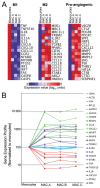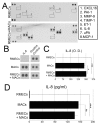Myeloid angiogenic cells act as alternative M2 macrophages and modulate angiogenesis through interleukin-8
- PMID: 21670847
- PMCID: PMC3188859
- DOI: 10.2119/molmed.2011.00129
Myeloid angiogenic cells act as alternative M2 macrophages and modulate angiogenesis through interleukin-8
Abstract
Endothelial progenitor cells (EPCs) promote angiogenesis, and clinical trials have shown such cell therapy to be feasible for treating ischemic disease. However, clinical outcomes have been contradictory owing to the diverse range of EPC types used. We recently characterized two EPC subtypes, and identified outgrowth endothelial cells as the only EPC type with true progenitor and endothelial characteristics. By contrast, myeloid angiogenic cells (MACs) were shown to be monocytic cells without endothelial characteristics despite being widely described as "EPCs." In the current study we demonstrated that although MACs do not become endothelial cells or directly incorporate into a microvascular network, they can significantly induce endothelial tube formation in vitro and vascular repair in vivo. MAC-derived interleukin-8 (IL-8) was identified as a key paracrine factor, and blockade of IL-8 but not vascular endothelial growth factor (VEGF) prevented MAC-induced angiogenesis. Extracellular IL-8 transactivates VEGFR2 and induces phosphorylation of extracellular signal-regulated kinases. Further transcriptomic and immunophenotypic analysis indicates that MACs represent alternative activated M2 macrophages. Our findings demonstrate an unequivocal role for MACs in angiogenesis, which is linked to paracrine release of cytokines such as IL-8. We also show, for the first time, the true identity of these cells as alternative M2 macrophages with proangiogenic, antiinflammatory and pro-tissue-repair properties.
Figures







References
-
- Urbich C, Dimmeler S. Endothelial progenitor cells: characterization and role in vascular biology. Circ Res. 2004;95:343–53. - PubMed
-
- Sekiguchi H, Ii M, Losordo DW. The relative potency and safety of endothelial progenitor cells and unselected mononuclear cells for recovery from myocardial infarction and ischemia. J Cell Physiol. 2009;219:235–42. - PubMed
-
- Fadini GP, Agostini C, Avogaro A. Autologous stem cell therapy for peripheral arterial disease meta-analysis and systematic review of the literature. Atherosclerosis. 2010;209:10–7. - PubMed
-
- Gao D, et al. Endothelial progenitor cells control the angiogenic switch in mouse lung metastasis. Science. 2008;319:195–8. - PubMed
Publication types
MeSH terms
Substances
Grants and funding
LinkOut - more resources
Full Text Sources
Other Literature Sources
Miscellaneous

